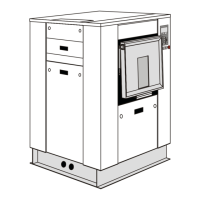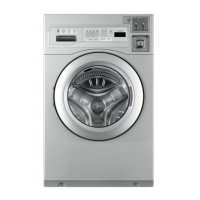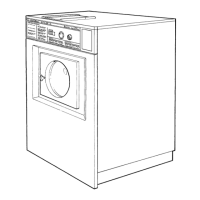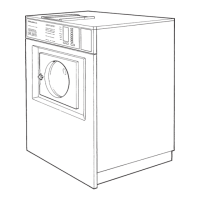Do you have a question about the Wascomat EXSM 230 S and is the answer not in the manual?
Safety and warning signs located on the machine's instruction panel.
Safety and warning signs located at the rear of the machine.
Safety and warning signs located on the machine's door.
Provides diagrams and measurements for machine dimensions.
Details the process and requirements for creating a machine foundation.
Steps and guidelines for the mechanical setup of the machine.
Procedures and considerations for connecting the machine electrically.
Instructions for connecting optional external equipment to the machine.
Details on how to connect the machine to water supplies.
Instructions for properly connecting the machine's drain hose.
Guidelines for connecting the optional steam heating system.
Procedure for installing the liquid supply manifold on the machine.
Overview of the machine's general design and components.
Identifies and describes the primary functional units of the machine.
Details the materials and assembly of the machine's outer shell and inner cylinder.
Describes the construction and lubrication of the back gable and bearing assembly.
Explains the components and function of the machine's door lock mechanism.
Details the function and operation of the door lock control unit.
Explains the LED flash patterns used to indicate machine errors or faults.
Describes the microprocessor-controlled motor control unit and its functions.
Details the components of the machine's electrical supply unit.
Describes the machine's motor, its control, and features.
Provides guidance for troubleshooting common motor and bearing issues.
Identifies connectors and functions for the E10 motor control unit.
Explains the communication and operation of the motor control unit.
Describes the green LED indicators for normal operation and current limiting.
Explains how the system monitors and handles load imbalance during extraction.
Provides instructions for troubleshooting and repairing supply injection valves.
Describes the construction and operation of the inlet valve.
Details the main parts and self-clearing design of the drain valve.
Guidance on cleaning and repairing the drain valve, and motor replacement notes.
Step-by-step instructions for tensioning the return spring in the valve housing.
Describes the three-compartment soap supply box and its usage.
Details the buttons, symbols, and display on the machine's control panel.
Step-by-step guide on how to select a program and start the washing process.
Specific instructions for operating the machine using coins for payment.
Provides checks for common issues when the machine fails to start.
Instructions for programming prices and settings for coin-operated machines.
Detailed steps for setting the prices for different wash programs.
Lists wash formulas tailored for hospitality environments like hotels and restaurants.
Lists wash formulas designed for healthcare facilities like nursing homes and hospitals.
Lists specific wash programs for different types of shirts.
Describes the electronic control unit, its inputs, outputs, and microprocessor functions.
How to check machine operating time, coin value, and EPROM part number.
Steps to enter service mode and check accumulated operating time.
Procedure to retrieve the Program EPROM part number from service mode.
Description of the level control system and how to check its function.
Steps for authorized personnel to check the level control and identify faults.
Overview of the service program for function checking and fault-finding.
A summary of error codes and their potential causes and actions.
How faults and errors are indicated on the control panel display.
Detailed list of error codes, their symptoms, fault-finding steps, and causes/actions.
Guide for diagnosing and resolving error code 01E related to water level.
Guide for diagnosing and resolving error code 02E related to door status switch.
Guide for diagnosing and resolving error code 03E related to door lock.
Guide for diagnosing and resolving error code 06E related to water level sensing.
Guide for diagnosing and resolving error code 07E related to water level safety.
Guide for diagnosing and resolving error code 10E related to water level after drain.
Guide for diagnosing and resolving error code 12E related to EPROM reading.
Guide for diagnosing and resolving error code 14E related to level system calibration.
Guide for diagnosing and resolving error code 17E related to door lock/status switch.
Guide for diagnosing and resolving error code 20E related to interlock signal.
Steps for diagnosing a machine that is completely dead or has a blank display.
Steps for diagnosing a blank display on an otherwise working machine.
Daily checks and cleaning procedures for the machine.
Weekly maintenance tasks, including cleaning the drain valve.
Quarterly maintenance checks, including V-belt and leak checks.
Checks to perform when the machine fails to start.
Troubleshooting steps for issues related to water not draining from the machine.
Steps to diagnose and fix issues with the machine not extracting properly.
Troubleshooting steps when the motor does not run at the correct wash speed.
Diagnosing and resolving slow wash speeds or unusual noises.
Steps to address metallic noises originating from the rear of the machine.
How to check and fix leaks around the machine door.
Procedures for fixing leaks around the door glass.
Troubleshooting steps when the machine fails to fill with water.
Steps to take if the machine continues to fill with water indefinitely.
Troubleshooting when water flows out without the machine filling.
Instructions for tightening mounting bolts to reduce excessive machine vibration.












